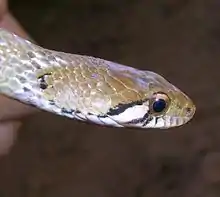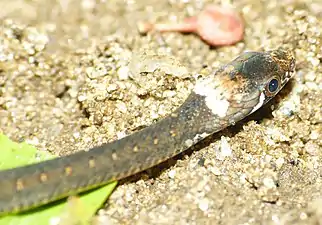Nilgiri keelback
The Nilgiri keelback or Beddome's keelback (Hebius beddomei) is a species of snake found in the Western Ghats in India.[1] The species is named after Richard Henry Beddome, 1830–1911, British army officer and botanist.[3] It was first discovered near the Nilgiris but is now known more widely from the Western Ghats. This snake is terrestrial and feeds on toads.
| Nilgiri keelback | |
|---|---|
 | |
| Scientific classification | |
| Kingdom: | Animalia |
| Phylum: | Chordata |
| Class: | Reptilia |
| Order: | Squamata |
| Suborder: | Serpentes |
| Family: | Colubridae |
| Genus: | Hebius |
| Species: | H. beddomei |
| Binomial name | |
| Hebius beddomei (Günther, 1864) | |
| Synonyms[2] | |
| |
Description
- See snake scales for the terminology used
Eye moderate, its diameter in the adult equalling its distance from the nostril; rostral just visible from above; suture between the internasals as long as that between the prefrontals; frontal larger than its distance from the end of the snout, a little shorter than the parietals; loreal as long as deep or deeper than long; one preocular; three (rarely two) postoculars; temporals 1+1 or 1+2; upper labials 8 or 9, third, fourth and fifth, or fourth, fifth, and sixth entering the eye; 5 lower labials in contact with the anterior chin shields, which are shorter than the posterior.
Scales in 19 rows, rather strongly keeled, the outer however, perfectly smooth. Ventrals 131-150; anal divided; subcaudals 65-75.
Brown above; a series of yellow spots, each between two black spots or short transverse bands, along each side of the back; upper labials yellowish with black sutures; a yellow, black-edged, oblique streak from the eye to the gape; a yellow band across the nape, behind the parietals, becoming indistinct with age; belly white, closely dotted with brown on the sides.
Total length 51–66 cm (20–26 in), tail 13–19 cm (5–7 1⁄2 in).[4]
 Beddome's keelback feeding on Duttaphrynus melanostictus
Beddome's keelback feeding on Duttaphrynus melanostictus The young have a white patch on the nape
The young have a white patch on the nape An adult, without white patch on nape
An adult, without white patch on nape
Habitat
It's found in the tropical rainforests and tropical moist forests of the Nilgiri hills.
Behavior
Although not aquatic, it can be found actively hunting from dawn to dusk on stream banks or close to other bodies of water.[5]
References
- Srinivasulu C, Srinivasulu B, Vijayakumar SP, Jose J, Kulkarni NU (2013). "Hebius beddomei". IUCN Red List of Threatened Species. 2013. Retrieved 7 September 2014.CS1 maint: ref=harv (link)
- Hebius beddomei at the Reptarium.cz Reptile Database. Accessed 7 September 2014.
- Beolens B, Watkins M, Grayson M (2011). The Eponym Dictionary of Reptiles. Baltimore: Johns Hopkins University Press. xiii + 296 pp. ISBN 978-1-4214-0135-5. ( (Amphiesma beddomei) p. 21).
- Boulenger GA (1893). Catalogue of the Snakes in the British Museum (Natural History). Volume I., Containing the Families ... Colubridæ Aglyphæ, Part.. London: Trustees of the British Museum (Natural History). xiii + 448 pp. + Plates I -XXVIII. (Tropidonotus beddomii, pp. 252-253).
- Das I (2002). A Photographic Guide to Snakes and other Reptiles of India. Sanibel Island, Florida: Ralph Curtis Books. 144 pp. ISBN 0-88359-056-5. (Amphiesma beddomei, p. 17).
Further reading
| Wikimedia Commons has media related to Amphiesma beddomei. |
- Günther ACLG (1864). The Reptiles of British India. London: The Ray Society. (Taylor and Francis, printers). xxvii + 452 pp. + Plates I-XXVI. (Tropidonotus beddomii [sic], p. 269 + Plate XXII, fig. E). PDF
- Smith MA (1943). The Fauna of British India, Ceylon and Burma, including the Whole of the Indo-Chinese Sub-region. Reptilia and Amphibia. Vol. III.—Serpentes. London: The Secretary of State for India. (Taylor and Francis, Printers). London. xii + 583 pp. (Natrix beddomei, p. 306).
